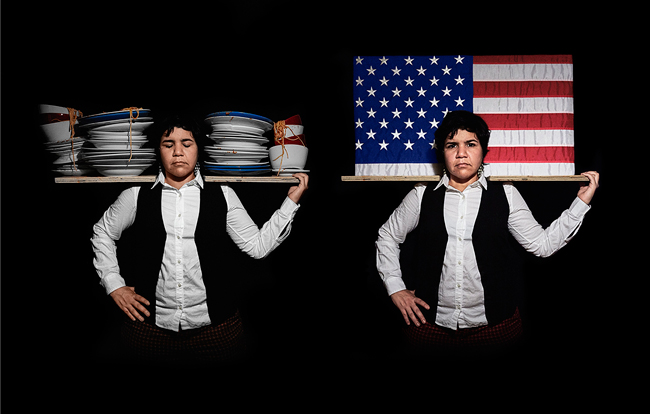
Art that Demands Justice
Queer artist Violette Bule illuminates the plight of the pandemic’s “essential workers.”

Like many no-longer-supportable social realities that have been exposed during the COVID-19 pandemic, the service industry is facing massive calls for total reinvention. All of the actors, poets, painters, and stand-up comics who survive by waiting tables are asking the same questions: Can I afford to do this anymore, knowing that when the next crisis comes I will be screwed once again? And can I afford to quit waiting tables and train for other employment?”
How do we address the implications of this reality beyond 2020? The demands for fair treatment of “essential workers” and the demands for racial justice are interrelated, and they certainly open up more questions than answers.
Artist Violette Bule was born and raised in Venezuela, one of the few developed countries facing a near-total lack of a functioning government and public safety net. Bule makes visible in her art all of the inequalities that we usually try to ignore in order to avoid being in a constant state of panic.
In an imposing sculpture entitled Homage to Johnny (2015–2018), Bule recalls a co-worker from a restaurant job she had when she first arrived in New York City. Johnny used to clean the silverware at a fancy restaurant in Manhattan for $5 an hour. Johnny doesn’t know how to speak English or Spanish. He is from Mexico and he only speaks the indigenous Nahuatl language, so even the City inspectors that look into immigrant working conditions could not communicate with him.

The sculpture is a wall of 1,509 metal forks attached to a magnetized metal restaurant door. It’s stunning in its mass, and yet just a small visual fragment symbolic of the underpaid labor that makes an elite lifestyle possible.
When Tribute to Johnny was last exhibited, Bule extended her narrative by mounting her Dream America (2015), a two-panel portrait of a strong woman shouldering a mass of badly balanced dirty plates on the left and a U.S. flag on the right. Her face appears determined to prosper and survive in any conditions, with an awareness of the worth of her labor.
Dream America is based on the revered August Sander photo-series Citizens of the 20th Century, a 40-year project that set out to document everyday German citizens through the lens of their professions. Sander’s lifelong project manifests the troubling idea that one’s class and economic realities are as fixed as height and eye color. His pastry chef is as corpulent and self-satisfied as you would imagine, but even he appears beaten down by the rigors of creating sugary treats for strangers. Yet there is a strange hopefulness in Sander’s ambitious mission and his faith that every citizen could and should be seen, and is worthy of being recorded for posterity.
Despite being a relatively recent Houston arrival who followed her partner here (who enrolled in the University of Houston’s prestigious writing program), Bule has embraced the city’s grand diversity. Not surprisingly, the unfairness of the nation’s immigration and labor policies is seen in Bule’s work. Dream La Bestia (2015) is a giant painted version of the Snakes and Ladders game in which you can play-act the life-threatening adventures of trying to cross the U.S.-Mexico border. Viewers can choose to play either an immigrant or a border agent.

In a less-tragic vein, Bule has been venturing into the realm of public art by creating life-affirming projects for communities that have borne the brunt of the pandemic. Working with the nonprofit Avenue CDC that builds affordable housing in Houston’s near Northside, she created a jubilant mural entitled Thank You, Essential Workers with the phrase “Community work makes us stronger” in English and Spanish. The 15 mural figures of local community leaders are easily visible from the light-rail line. As a remembrance of 2020, the mostly Black and Brown faces are wearing face masks, and the emphasis on restaurant and janitorial work seems perfect. A closer look also reveals BLM and DACA written on some of the workers’ shirts, a detail that will forever tie the mural to the events of 2020.
The Art League Houston and Houston Arts Alliance supported “Rethinking Your Neighborhood,” an enhanced-reality project taking place in Irvington Park, also on the near Northside, in which the results of the several interviews with area artists are presented as both virtual-reality games and a a 3-D urban-planning project with movable units representing different types of buildings—houses, stores, and art centers. Visitors can listen to their neighbors’ worries and try to solve issues through their insights about their own neighborhood by placing building models on the neighborhood street grid.
I was first drawn to Bule’s work after seeing this queer artist’s images of gay male eroticism. I included a large photograph of masturbating Venezuelan soldiers in my Stonewall 50/50 exhibition at Alabama Song last year. I love when she inverts gender roles in art history, such as recreating Manet’s Le Dejeuner sur l’herbe with a cute, modestly exposed guy replacing Manet’s inexplicably naked female. Queer themes run through the work she did during her student days in Mexico in the ’90s. But her current focus, since arriving in Houston in 2018, seems to be the Texas Latino population’s increasingly crucial role in turning the state blue in the November elections. Her championing of the power of Latino women in creating a better future for Texas helps in that effort, and I am pretty sure that all evolved humans can agree that turning Texas blue must be our top priority in 2020.
For more information on Violette Bule, visit violettebule.com.
This article appears in the July 2020 edition of OutSmart magazine.











Comments